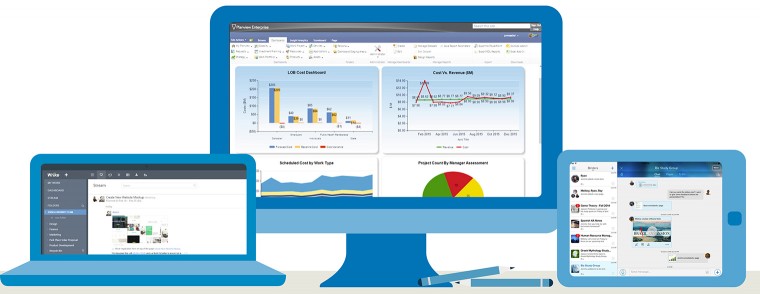Tools! Technology tools galore! It can be a full-time job just working out what to use. Based on responses from some 100 executives in project management, here is a rundown of which ones they are using. It’s a mix of oldies, goodies and some newbies.
One of the best new tools is Moxtra. This messaging service is the latest creation of Subrah Iyar, famous for founding WebEx, the source of his £450-million personal fortune.
Moxtra is a mobile app which fuses lots of the essentials for project management into a single interface. This includes meetings, conversations, screen-sharing, signatures and more. It makes sharing documents easy and offers clever add-ons such as recording voice notes. There is some similarity to WebEx, naturally, but Moxtra is targeted to be far broader.
The objective is to make it easier to bring teams together, resolve issues and get approvals faster
“Mobile collaboration is rapidly evolving to empower workers to accomplish more on their smartphones and tablets,” says Mr Iyar. “In fact, according to Gartner, by 2018 50 per cent of team co-ordination and communication will occur via mobile group collaboration.”
Moxtra was built with this in mind. He adds: “Downloading attachments and searching for project content is no longer necessary. The objective is to make it easier to bring teams together, resolve issues and get approvals faster.”
Launched in 2013, it’s getting strong reviews. With such a strong team behind it, Moxtra is bound to have a major impact in the industry.
Another mobile tool is ElecoSoft’s Site Progress Mobile. Designed by a UK project management developer, it enables project managers to update their projects on the move. United House, a UK house-builder with 1,000 projects to manage at any one time, has adopted it wholesale. Site Progress Mobile integrates well with Asta Powerproject, a tool used by 90 per cent of the UK’s largest construction contractors.
A big hit recently is Wrike, a comprehensive project management tool. It’s got the lot – collaborative document editing, time-tracking, access control, a newsfeed to keep participants up to date, visual dashboards and task-setting so you can actually run the project. Translated into ten languages, Wrike now has more than one million users across 8,000 companies in 120 countries.
What do the users think? Ciaran Rogers at Isle of Wight sailing charity UKSA says: “Wrike enables me to break projects down into component parts, allocate these project parts to the 12 members of my team and link work together in a linear workflow. I can see the full picture of workflow across multiple projects and move or reprioritise projects around as deadline pressures and senior management priorities require. It’s a bit like giving me a conductor for my orchestra. We play a much better tune now that we have Wrike.”
A tool which goes from strength to strength is Huddle. It’s ideal for file-sharing and project management in the cloud. It boasts three quarters of a million accounts. A big advocate is the Department of Energy & Climate Change (DECC). It has 300 Huddle users on its smart meter programme. Some are DECC employees, others work for energy suppliers, network operators, consumer groups, the Ofgem regulator and others.
David Rigal, senior policy adviser and programme operations manager at DECC, says: “We have multiple work streams collaborating in parallel. Each work stream has one or more dedicated Huddle workspaces that individuals are invited into. Here they can share, review, edit and approve documents in a way that is infinitely faster and more secure than e-mail.”
Is it value for money? Mr Rigal says: “My estimate is that Huddle at times does the work of three or four civil servants, who might otherwise have to manage meetings and supporting paperwork. Overall we estimate the cloud collaboration platform has saved more than £100,000 annually in staff and other resources.”
For smaller enterprises Basecamp is still the undisputed king. The company claims more than 15 million people have used Basecamp – which is remarkable.
For managing a portfolio of projects, Planview is popular. Customers include Carlsberg, Sony and Eurotunnel. A key feature is its versatility in working with traditional and agile project management platforms such as Rally and Jira.
Sky uses CA Technologies’ PPM software to track more than 2,000 projects. It co-ordinates 4,000 employees using CA PPM.
Yammer is a powerful presence in the business collaboration space. Trello, an online management tool and “to do list”, is gaining ground in the government digital services platform GOV.UK. Not a bad client to have. Clarizen provides business automation for large enterprises and is used by the likes of Deloitte. Concrete is an activity planner used by Marks and Spencer.
A key issue is how these tools fit together. At Critical Software, senior project manager Luke Walsh uses a lot of packages. He says these run “from the well-known, such as Skype and Google Hangouts for quick communication and cross-site meetings, to more technical systems, such as Jira, Mantis, Sharepoint and Redmine, and also presentation and meeting software, such as join.me”.
Bespoke software company Objectivity uses agile development in four locations in three countries – the UK, Australia and Poland. It uses Jira to track issues, Skype for business to chat and Citrix GoToMeeting is used when the conversation gets more serious. Objectivity group management director Peter Brookes-Smith recalls using Google Doc and Hangout for messaging and video-calling during a project with 60 participants. There was heavy reliance on these simple tools, but with a happy outcome. He concludes: “Sometimes it’s not the specialist tools that are the most useful for a project manager.”

